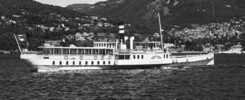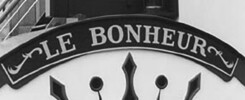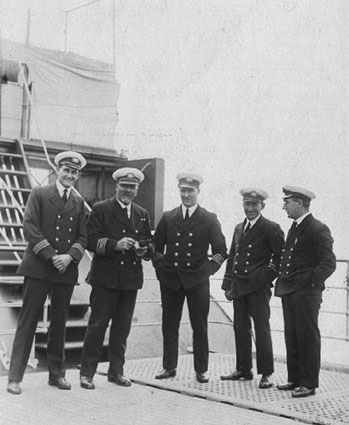
1st November 2002 marks the 40th anniversary of the death of Chief Engineer Bill Peake (pictured centre aged 30) aboard the paddle steamer Golden Eagle in July 1929 with, from left to right, Second Engineer Barnes, Capt Bill Branthwaite, Second Mate Whiting and an unidentified officer.
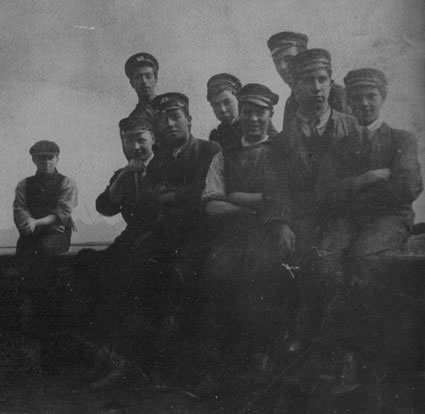
Bill Peake started work as an Apprentice Engineer (fourth from the right) with the General Steam Navigation Company at their Stowage Repair Works at Deptford in 1916.
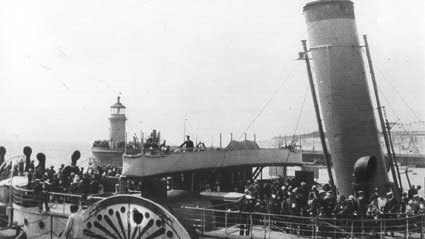
After serving with the Royal West Kent Regiment, Bill went to sea as third engineer on several GSN cargo ships before joining the paddle steamer Eagle (pictured above) serving under her Chief Engineer Julius Prior. He obtained his Class 1 MOT Certificate of Competency in 1928 and was then appointed Chief Engineer of the Golden Eagle standing by her the following winter whilst she was converted to oil firing.
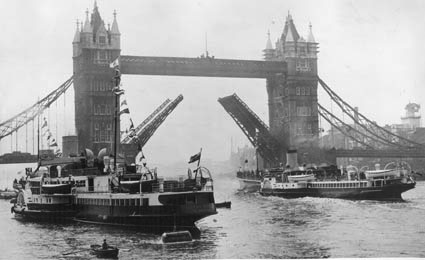
In 1932 Bill was appointed Chief Engineer of the Crested Eagle (pictured right with the Royal Eagle on the left on the buoys off Tower Pier on 19th May 1934) running the long day trips leaving Tower Pier at 9am, calling at Greenwich 9.30am, North Woolwich 10am, Tilbury 11am, Southend 11.45am and Clacton 2pm before sailing on to Felixstowe for 2.55pm. Return was just five minutes later at 3pm with similar calls on the way back to Tower Pier for 8.35pm.
This was a long trip, particularly on days punching the tide both ways, with little margin built into the timetable for making up any delays. And with twelve calls in a day, the manoeuvring alongside the piers had to be smart, quick and efficient with team work and rapport between the captain on the bridge, the chief engineer on the engine controls and the rope handlers. A loss of just five minutes per pier would have made the ship 5 mins x 12 piers = 60 minutes late back in the evening. A ten minute loss a full two hours late. And a fifteen minute loss per pier three hours late back which would not have pleased the passengers, the management or any crew members looking forward to maximum drinking time in the pub ashore afterwards.
On the return trip, as passengers disembarked at Greenwich, the day’s empty beer bottles were landed in crates for transhipment to a nearby brewery and the next day’s supply loaded aboard by casual dock labour who must have thought it worthwhile waiting at the pier for the chance of the extra work and, perhaps, the odd mislaid bottle of beer.
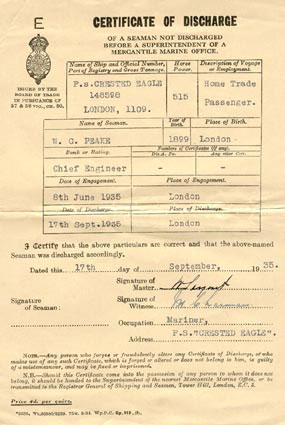
The days were long with the twelve hours or so of steaming time extended with bunkering and getting the ship ready in the morning and with cleaning up after hundreds of passengers, restocking the bars and galley and carrying out any necessary machinery maintenance in the evening. But for the larger steamers, which had operating costs commensurate with their size, the seasons were comparatively short taking advantage only of the peak weeks when trade was likely to be brisk. Bill Peake’s Certificate of Discharge for 1935 shows the Crested Eagle going on articles on 8th June and finishing on 17th September. Kingswear Castle’s season starts in mid to late April and finishes at the end of October.
This certificate was witnessed by John Charman who is pictured below when he was the Chief Officer of the Crested Eagle. Capt Charman also sailed as master of the Queen of Kent and later became a Trinity House Pilot working on the Thames.
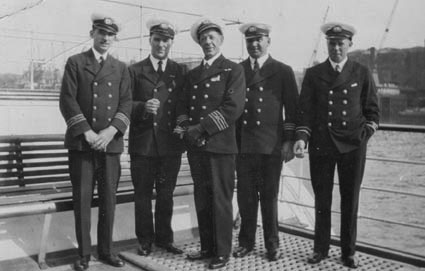
Aboard the Crested Eagle in the early 1930s with, from left to right, Second Engineer Aubrey Holt, Chief Engineer Bill Peake, Capt Cole, Chief Officer and later Capt John Charman and the Second Officer whose name is unknown. The Second Officer for a time in the 1930s was Mr Kelly from Anglesea who went on to become Capt Kelly, Master of the Royal Sovereign, after the war.
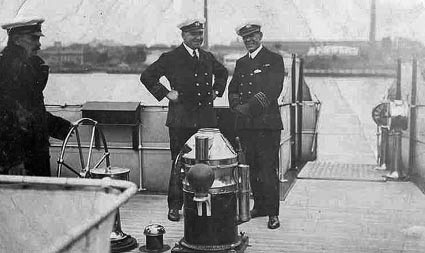
Capt Cole with Chief Officer Charman and an unknown helmsman on the Bridge of the Crested Eagle. At about half the more usual height, the binnacle seems a tad on the short side and, for some reason, is separated from the ship’s wheel by what looks like an air vent to the captain’s cabin below. Perhaps in this way the captain could more conveniently eavesdrop conversations when he wasn’t on the bridge!
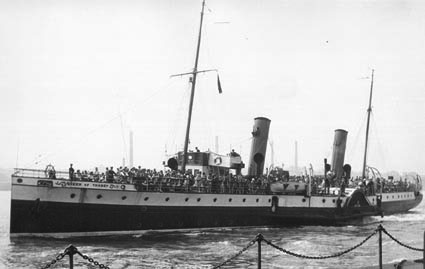
At the end of 1937, at the age of 38, Bill Peake was appointed Engineer Superintendent of the New Medway Steam Packet Company and had responsibility for all engineering aspects of the fleet which, at that time, included the two new motor vessels Queen of the Channel and Royal Sovereign and the paddle steamers Medway Queen, Thames Queen, Essex Queen, City of Rochester, Queen of Kent and Queen of Thanet (pictured above berthing at Tilbury in the 1930s).
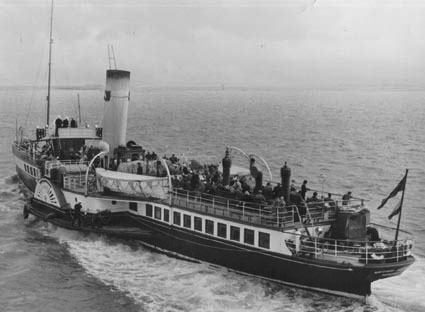
In 1951 Bill Peake was appointed a director of the New Medway Steam Packet Company which continued to operate the paddle steamer Medway Queen (pictured above) until 1963 against a background of decline in the excursion trade nationwide and its eventual collapse in the 1960s.
Bill took over as the Managing Director of the company on the retirement of Mr O’Keefe who, in turn, had taken over from Capt Shippick who reconstituted the company after the First World War. The latter started his paddle steamer career as mate on the steamers of Cosens and Company of Weymouth before the First World War so there are interesting links between the Dorset Coast and the Medway.
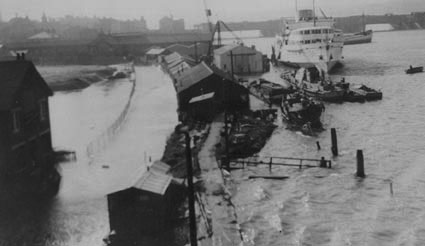
The Acorn Shipyard, Strood, home of the New Medway Steam Packet Company and Bill Peake’s base, experiencing flooding during a very high tide with the Royal Sovereign alongside in 1953.
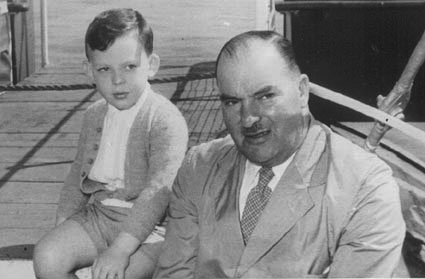
Pictured here with his son, Alan, now Chairman of the Paddle Steamer Kingswear Castle Trust, Bill Peake died whilst in post as the Managing Director of the New Medway Steam Packet Company at the young age of 63 on 1st November 1962.
Kingswear Castle continues the paddle steamer tradition on the Medway and Thames and has now sailed in the area for as long as the Eagle and longer than several other famous paddle steamers from the past including La Marguerite, Halcyon, Crested Eagle, Royal Eagle, Clacton Queen and Laverock and, not counting the war years when they were doing other things, Queen of Kent and Queen of Thanet.
The Acorn Shipyard at Rochester still exists today, although under different management, and Kingswear Castle goes there each year for her annual slipping.
Kingswear Castle returned to service in 2023 after the first part of a major rebuild which is designed to set her up for the next 25 years running on the River Dart. The Paddle Steamer Kingswear Castle Trust is now fund raising for the second phase of the rebuild. You can read more about the rebuilds and how you can help if you can here.
John Megoran

